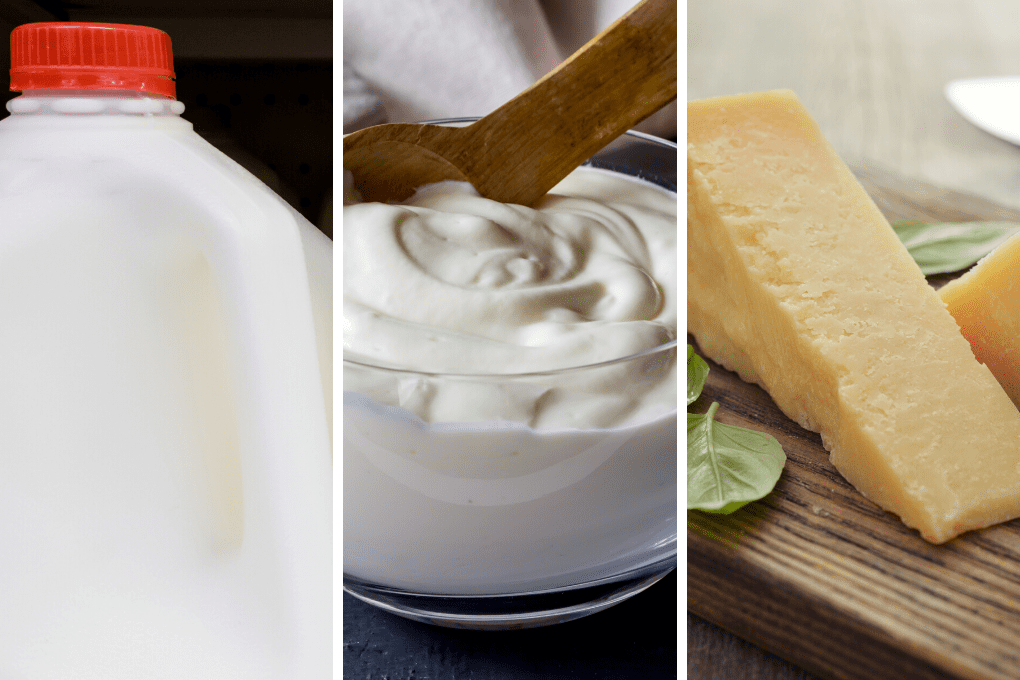
Have you ever been in my shoes and bought too much milk to use before it goes bad? Or, your cheese is close to its sell-by date and you don’t think you will use it in time? Or, you don’t know how to fit everything in your fridge after a big grocery store trip? The short and simple answer: Freeze your dairy foods.
Is freezing dairy safe?
Yes. According to the USDA, “Food stored constantly at 0°F will always be safe. Only the quality is affected with lengthy freezer storage. Freezing preserves food for extended periods because it prevents the growth of microorganisms that cause both food spoilage and foodborne illness.”
Does freezing affect the nutrient composition or retention of the dairy product?
No, there are little to no nutrient changes that occur.
How do I freeze dairy products?
You can freeze milk, cheese, and yogurt simply in your freezer like you would any other food product.
Milk: Try freezing in a plastic or glass freezer-safe container. Avoid freezing milk in paper cartons, as they are not airtight and can potentially leak. Plan to leave about 1 to 2 inches of space at the top, as milk expands slightly when it freezes (similar to other liquids) and leaving space in the container is important to avoid bursting.
Cheese: Portion out the cheese in a way that you would use it or consider grating the cheese prior to freezing. To prevent freezer burn, wrap the cheese in parchment paper and then again with aluminum foil. You can vacuum-seal your portions. Keep in mind harder cheeses like cheddar, Swiss, and Parmesan freeze better than soft cheeses like cottage cheese, ricotta, and Brie. With softer cheeses, the curds and whey separate leaving a watery and grainy product.
Yogurt: Because yogurt is partially liquid, it will expand slightly when you freeze it. You can freeze yogurt in its original container or another airtight container, but be sure to leave 1 to 2 inches of space at the top to prevent the container from bursting. One way to freeze thick yogurt is by scooping it onto a tray lined with parchment paper. Once frozen and hard, you can transfer into an airtight container for storage in the freezer. Yogurt can also be frozen through some recipes like our PB+J Yogurt Bark, Unicorn Yogurt Bark, or Chai Tea Latte Yogurt Popsicles.
How long can I keep frozen milk, cheese, or yogurt in the freezer?
According to the USDA, the length of time to keep dairy products in the freezer at 0°F varies by product.
| Product | Safely store in the freezer up to: |
| Milk | 3 months |
| Cheese | 6 months |
| Yogurt | 1 to 2 months |
How do I thaw milk, cheese, and yogurt?
Dairy products should be thawed gradually, in the refrigerator at 32–34 °F. It may take up to 24 hours depending on the size of the container you used, so plan accordingly. There are a few additional specifics:
Milk: When you’re ready to use your thawed milk, stir or shake your milk well before using to restore smoothness, as normal separation can occur. It is normal for thawed milk to taste different. Use in a recipe where taste will be muted such as oatmeal, smoothies, or muffins.
Cheese: Because the freezing process develops ice crystals, the cheese’s texture may be drier or more crumbly. If this occurs, use it in sauces or soups where the texture won’t be noticed. Use your defrosted cheese within 2-3 days.
Yogurt: Frozen yogurt may not defrost to the same consistency however, you can still use it in baking recipes. Frozen yogurt can also be used straight from the freezer to be used in smoothies.
What are some benefits of freezing dairy?
There are many benefits to freezing dairy products:
- Free up refrigerator space.
- Save money by buying fresh dairy products in larger sizes.
- Wasting less by freezing before the sell-by date (instead of throwing it away).
- Getting the most out of your dollars spent; when you throw food away you throw money away.
Other helpful tips:
- If you’d like to learn more about the sell-by dates, visit the USDA’s website for more information.
- Label your container with the date you’re freezing it and how many days until expiration. This way you know when thawing it how many days you have to drink or eat it.
- Try freezing milk in ice cube trays. You could even add these to a glass of milk, chocolate milk, or coffee to keep it cold without diluting your drink.
- Freeze yogurt in ice cube trays to quickly add to smoothies or smoothie bowls – you can even freeze berries or spinach in the yogurt cubes for an added boost.
Video Playlist: How To Freeze Different Dairy Products
Video Playlist En Español: Cómo Congelar Productos Lácteos
Articles part of this series: Can You Freeze Milk? | Can You Freeze Yogurt? |
Can You Freeze Cheese?



